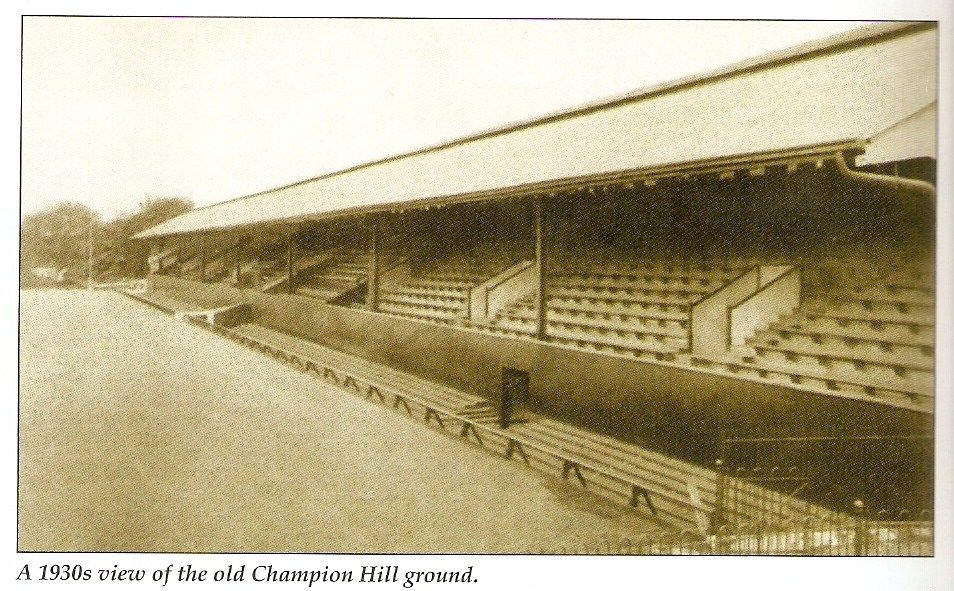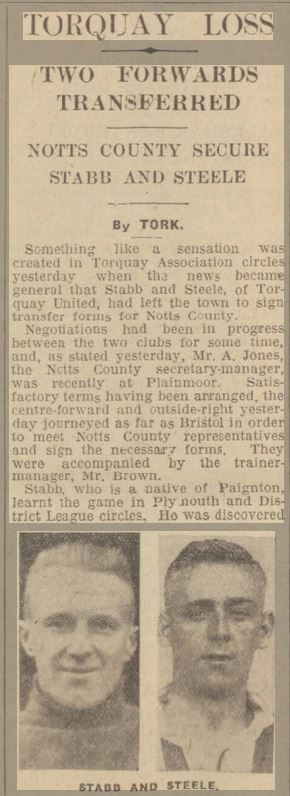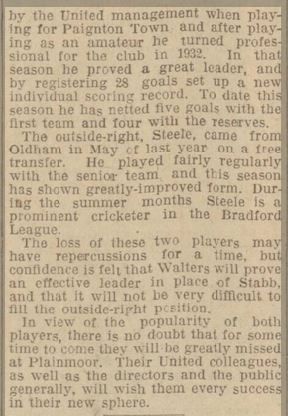|
|
Post by gullone on Oct 28, 2014 17:13:06 GMT
|
|
|
|
Post by gullone on Oct 28, 2014 17:17:47 GMT
|
|
|
|
Post by gullone on Oct 28, 2014 17:23:07 GMT
|
|
Deleted
Deleted Member
Posts: 0
|
Post by Deleted on Oct 30, 2014 19:01:55 GMT
Dulwich Hamlet. Are they still in the FA Trophy? I believe they are. This is the second of two meetings we've had with them in the FA Cup. One in 1934/35; the other in 1935/36. We won both games - by 2-1 and 3-2 - in front of, according to the centenary history, respective crowds of 9,000 and 11,640 at Champion Hill, London SE22. Hamlet won both the Isthmian League and the FA Amateur Cup during the 1930s; arguably the club's golden age. You can imagine considerable interest surrounded both matches. The old Champion Hill ground was said to hold 30,000 although I can't find a larger crowd recorded than the 20,744 which witnessed the FA Amateur cup final between Kingstonian and Stockton in 1933. The main stand (pictured below) held 2,400 and was opened in 1931. Hamlet continued to play at the ground until the early 1990s when it was sold off to Sainsburys and the club moved to an adjoining site.  The programme starts with a welcome to Torquay United and a look back to the previous season's tie. Our departed centre-half would have been Don Welsh who'd gone to Charlton Athletic. I'm assuming the centre-forward was Tom Walters who had since joined Watford. "Forced financial stringency" at Plainmoor in 1935 so just twenty professionals this season. But life's looking up and Torquay United's fame is being spread around so that the club can "enjoy the pleasure of what earlier hard work has now culminated in a comfortable playing and financial position". It's good to see "pen portraits" of Torquay's players in the programme; always useful for putting the flesh on the bones of raw statistics. There's some revealing descriptions: Green "not built for hurly-burly"; Hunt "does not profess to be a Dixie Dean"; Hutchinson "hard working without show or class" (something may have been lost in translation here). Morgan is perhaps "the most talked of player in the Division" (for good, rather than bad, you hope). Maggs, the goalkeeper did not appear in last season's tie because of a "temporary lapse of form". The same fate, of course, was to befall Martin Rice almost exactly eighty years later. |
|
Jon
Admin 
Posts: 6,912
|
Post by Jon on Oct 30, 2014 22:46:28 GMT
I'm assuming the centre-forward was Tom Walters who had since joined Watford. Our big centre-forward sale in 1934/35 was George Stabb - who went to Notts County for big money along with winger Ernie Steele. Walters was not retained at the end of the 1934/35 season. He had not been retained at the end of the 1933/34 season either, but we ended up re-signing having dodged having to pay his summer wages. "Forced financial stringency" at Plainmoor in 1935 Plus ça change. |
|
Deleted
Deleted Member
Posts: 0
|
Post by Deleted on Oct 31, 2014 9:49:59 GMT
Our big centre-forward sale in 1934/35 was George Stabb - who went to Notts County for big money along with winger Ernie Steele. Reading the programme again it's actually slightly ambivalent: "Last year our visitors team included a centre-forward and a centre-half who had established big reputations in the football world". The departure of Welsh (described by the centenary history as "the idol of Plainmoor") is noted; that of the centre-forward implied. George Stabb had been in Torquay United's team at the start of 1934/35 and it's quite possible he's the man the Dulwich Hamlet programme editor had in mind. But, checking the records, it appears Stabb left Plainmoor several weeks before we played at Dulwich. The man in possession was Walters. Maybe he'd briefly turned people's heads with his four goals against Newport County the week before Torquay went to Champion Hill. A fine achievement, of course, even though it's no longer our record individual haul against Newport. An excuse to revisit George Stabb's career; I'm sure we've been there before. 44 goals in 93 games; that would surely have established a "big reputation in the world of football". Paignton-born; Stabb later moved on to Port Vale and, in 1936, to Bradford Park Avenue. Wiki informs us Stabb was to die in Bradford in 1994 at the age of eighty-two. The centenary history tells us Ernie Steele was born in Middleton in 1908 and died in 1972. There are many Middletons; the largest is between Rochdale and Manchester. I tried to discover more about Ernie Steele and found this potted biography on the Mossleyweb site: Born in Leigh on 28th October 1911. Ernie Steel played for Middleton and Hurst before making a solitary appearance for Mossley. He then played for Rochdale, Oldham Athletic, Torquay United, Notts County, Bath City, Millwall, Crystal Palace (33-9), Rochdale, Stockport County, Rochdale, Carlisle United, Sheffield United, Chesterfield, Leicester City, Swansea Town, Hurst and Barry Town before returning to Mossley in 1947 making 16 appearances and scoring 1 goal. He later played for Wellington Town, Northwich Victoria and Ossett Town. Steele was later groundsman at Barnsley FC. A real football journeyman.Ernie Steel died on 16th April 1997.A confusion here is the swapping between Steel and Steele. The date and place of birth is different; the date of death is not the same. The number of clubs is enormous; it may have included the war and the aftermath. I don't have the books to see how many Ernie Steel(e)s played league football before the war. Then at - nonleaguezone.com/viewtopic.php?f=61&t=104872 - we have this: The Vase final between Bridlington Town and Tiverton Town would have been interesting to Ossett Town on two levels, Brid won 1-0, with Alan Radford scoring. On another more obscure level, Tiverton had in their team a defender called Hedley Steele who was born in Barnsley in 1954, but had spent his entire career in the south west, with the likes of Exeter City, Weymouth etc. Barnsley is the clue here, because Hedley's father was Ernest Steele, a professional footballer and cricketer who played for Ossett Town FC and Ossett CC in the early 1950's. Ernest had played league football with Oldham, Rochdale, Torquay, Notts County, Crystal Palace and Millwall before the war, then in non league football after the war. As a cricketer, he played in Lancashire's 2nd XI before embarking on a long career in club cricket. After leaving Ossett, he went to Barnsley CC, where he played alongside Michael Parkinson and Dickie Bird as well as being groundsman. He moved to Tiverton in the late 1960's where he was manager and later groundsman for Tiverton Town. He collapsed and died watching Tiverton in 1997 at the age of 86.This is interesting. Hedley Steele has been on the Devon football scene for over forty years; he's still around as assistant manager of Willand Rovers (and even made a substitute appearance last season at the age of sixty). His middle name is "Verity"; as in Hedley Verity the Yorkshire cricketer who died in Italy during WW2. This Ernie's death in 1997 ties in with a 1911 birth. Not a Yorkshireman; yet he was a cricketer. But is he the same Ernie? If so, I have visions of him nipping down to see Dickie Bird turn out for Paignton CC. And, speaking of Willand Rovers, I'm told that Luke Durham - who was sent off against Gosport - is the son of John Durham who played for Torquay United during the really dark days of the 1980s. John Durham wasn't quite from Barnsley. He was from nearby Wombwell. |
|
|
|
Post by hedley on Mar 8, 2015 21:48:42 GMT
Some interesting history there on my dad, Ernest Steele, birth and death dates are as posted and many of the club's listed are correct too. Got some team pics of his Torquay days. We did pop down to Paignton to see Dickie Bird when he had a benefit game there.
I'm still involved in footy with one of your leg-ends Hilly at Exmouth Town
|
|
Jon
Admin 
Posts: 6,912
|
Post by Jon on Mar 8, 2015 23:47:42 GMT
Some interesting history there on my dad, Ernest Steele, birth and death dates are as posted and many of the club's listed are correct too. Got some team pics of his Torquay days. We did pop down to Paignton to see Dickie Bird when he had a benefit game there. I'm still involved in footy with one of your leg-ends Hilly at Exmouth Town Welcome to the forum Hedley. Do you know if the cricket match was in 1967? Here's how the Western Morning News broke the sensational news of your dad's departure from Plainmoor: WMN 24/10/34   |
|
Deleted
Deleted Member
Posts: 0
|
Post by Deleted on Mar 9, 2015 8:53:43 GMT
Good to see Hedley's post. He may be the first contributor to this site who has played in the Football League for Exeter City. Indeed, checking Hedley's career just now, I'd not realised he made his Exeter debut against Barnsley at Oakwell.
Nor was I aware Hedley is now at Exmouth Town. I've been looking at their fixtures and may be tempted by the Monday evening game in April against St Austell.
Meanwhile it's Glossop North End for St Austell in the Vase semi-final. The home leg is the day of the Kidderminster game. Alpine Joe will have a dilemma.
I went to a Dickie Bird benefit game at Paignton. This was against a Torquay United XI. I'm not sure if this was a one-off or whether there were several of these fixtures. Jon is asking if it was 1967 when, to follow his line of questioning, Ken Brown may have made his Torquay United "debut" on the cricket field rather than football pitch.
I'd be surprised if I had the interest to go to such a game in 1967. I wasn't there with my parents so perhaps I went with a friend. I was thinking more of 1969 when, with my father ill, I was left to my own devices for much of the summer. Local press reports suggest Dickie Bird played for Paignton until 1968; his autobiography says 1969. It could have been possible.
But I can remember Eric Burgess playing for the Torquay United XI and he left for Argyle in July 1968. Unless he came back as a "ringer" it's starting to look like 1967. That rather staggers me. The summer between primary school and secondary school. Really?
|
|
Jon
Admin 
Posts: 6,912
|
Post by Jon on Mar 10, 2015 0:37:55 GMT
|
|
Jon
Admin 
Posts: 6,912
|
Post by Jon on Nov 30, 2018 0:34:24 GMT
   Only a one year gap from 1934 to 1935, but followed by an 83 year gap to 2018. A shame from a historical point of view that we do not return to Champion Hill, but maybe a blessing from a practical point of view. |
|
Rob
TFF member

Posts: 3,607
Favourite Player: Asa Hall
|
Post by Rob on Dec 2, 2018 0:11:50 GMT
On the subject of the November 24, 1934 FA Cup fixture, my programme tells me the team lined up as follows:-
Langford GK, Gregg RB, Tapp LB, Jones RH, Welsh CH, Rees LH, Morgan OR, Beedall IR, Walters CF, Hutchinson IL, Protheroe OL. It also states that Millington “travels as twelfth man”.
|
|